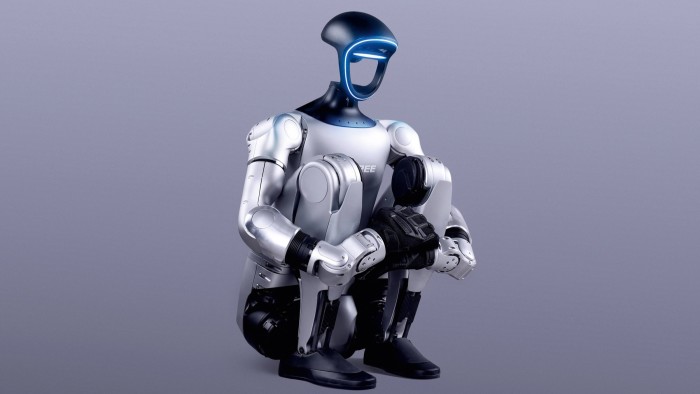For more than 100 years, writers, artists and filmmakers have sketched out their visions of the household robot, a supposedly inevitable culmination of human technological advancement. One day, these multitasking machines will, we’re told, perform tedious tasks efficiently and without complaint, respond courteously to requests and remain unobtrusively compliant and meek. In The Automatic Maid-Of-All-Work (1893), author ML Campbell described such a machine as “a queer looking thing, with its long arms [and] a face like one of those twenty-four hour clocks… each number was a sort of electric button. There were a lot of wires… [it] would be handy in lots of ways.” The fact that helpful, mild-mannered, multitasking domestic robots remain conspicuously absent from our homes is indicative of the profound engineering challenges involved in creating them, but that hasn’t stopped robotics firms – the vast majority in east and south-east Asia – making great efforts to hasten their arrival.
The annual Las Vegas electronics trade event, CES, can always be relied upon to give an update on how these efforts are progressing. This year humanoid robots, such as China’s Unitree G1, moved across the showroom floor with surprising grace, waving hello to onlookers but stopping noticeably short of doing any laundry.
Others, like Japanese startup Yukai Engineering’s fluffy Mirumi robot, won hearts by simply looking around appreciatively at people with mournful eyes while clipped to a handbag strap. Somewhere between those two extremes sat China’s Roborock’s Saros Z70, a standard-looking, disc-shaped vacuum bot with an extendable arm that was able to identify and pick up a discarded sock to allow it to clean underneath. A simple act, but one that seemed to elicit disproportionate delight.
“These kinds of tasks have always been confined to humans,” says Roborock’s Ruben Rodriguez. “So when you see a robot making a decision to try a little harder to clean up some mess, which is such a human thing to do – yes, it’s amusing!” Professor Kerstin Fischer, an expert on human-robot interaction at the University of Southern Denmark, agrees. “What we’re designing is like a version of ourselves, especially when they take over human tasks or enter human spaces,” she says. “So we get excited around them. They’re attractive to a high degree, and we have lots of hopes and expectations when we start to interact with them.”
Those expectations are often pitched a little high, as anyone who has owned and used a vacuum bot in their home will testify. Nevertheless, they have succeeded in becoming one of the first types of domestic robot to reach the mass market for a good reason: we can trust them to provide a specific and well-understood level of utility. “We’re seeing incremental improvements to a level where they’re completely different machines to, say, 10 years ago,” says Rodriguez. The widespread acceptance of that form factor has seen Roborock use it as an almost literal platform upon which to build. Ditto Switchbot, a Chinese company whose new K20+Pro is billed as a “multitasking household robot” – although switching between its various capabilities requires human assistance: pop a filter attachment on top of its vacuum base and it becomes a roving air cleaner; switch that out for a camera and it’ll prowl your home to monitor for intruders.
“We believe in specialised robots, working with connected hubs, sensors, cameras,” says Switchbot’s Richard Mou. “They’re all parts and organs of one single robot, called your home. At this time,” continues Mou, “we don’t believe in a humanoid robot that can do everything.”

But some are still valiantly pursuing that long dreamt-of goal of a humanoid lackey. In February, Norwegian robotics firm 1X unveiled a video of its latest creation, the Neo Gamma, whose form feels very much like a descendant of the Maschinenmensch robot featured in the early sci-fi film Metropolis (1927) or, for that matter, Star Wars’ C-3PO. It is shown living alongside a couple in a beautiful home, vacuuming its floors, cleaning windows and serving wine at dinner. According to CEO Bernt Børnich, if we’re genuinely seeking to offload our domestic chores to a robot, it has to take a humanoid form.
“Everything in your home is made for humans,” he says. “We spent centuries making everything as ergonomic as possible for us to use. Also, people don’t realise how much of our intelligence is actually part of our body, part of the way we move.” If they live with us, according to Børnich, they will learn from us. And Neo Gamma, he says, will shortly be introduced to a broader array of testers under a non-disclosure agreement. “The version after that will go to paying consumers,” he adds.
Professor Fischer has some doubts about the speed of this timeline. “A generalist, a robot that can do everything humans can do, seems to be very far from reality,” she says. “Just to move around, to coordinate with people, to move in social spaces – there’s so much knowledge there that’s very hard to model. One thing about robots is that they teach us how complex our dealings with the world really are.”
I was surprised at my feelings of mild sadness watching Neo Gamma at work. Call me a fool for attributing human qualities to a machine, but I found the spectacle of this rather put-upon entity executing thankless tasks, day and night, rather bleak. But maybe I need to push through that in order to appreciate a future that will, as Børnich puts it, be characterised by “labour in abundance”.
Perhaps my ideal domestic robot wouldn’t be a compliant servant, but an entity I like spending time with.

At CES, US maker Realbotix showcased a humanoid robot, Aria, that resembled a conventionally attractive woman with long blonde hair who could, thanks to generative AI, engage you in some kind of conversation – although it wasn’t particularly free-flowing. While undoubtedly an extraordinary engineering achievement (multiple motors in Aria’s face are used to give it appropriate expressions) the aim to create a robot “specifically for companionship and intimacy”, as Realbotix puts it, still feels a long way off.
Chinese firms EXDoll and Starpery are exploring similar territory in their sex-doll lines with features such as robotic movement, sensor-driven physical responses and AI-driven chat (albeit around one main topic). These could be termed “sex robots”, but according to a recent paper by Kate Devlin, professor of artificial intelligence at King’s College London, they stand apart from general robotics trends in that they’re “not programmable machines designed to automate a task… [their] autonomy is somewhat limited, and they are […] passive rather than active.
“Cost and access are also issues,” she writes in a recent paper, noting that one such robot (with an animatronic head and a doll body) costs more than $10,000. “The promise of an artificial partner is still far greater than what has been delivered [and] it seems likely, at the time of writing, that not much will change.”
This doesn’t, however, mean that non-humanoid robots can’t delight and amuse us. Chinese firm Hengbot attended CES with Sirius, a sleek robot puppy that responds to voice commands, has a playful, coquettish manner and is, of course, guaranteed not to soil your floor. Jizai, based in Tokyo, unveiled Mi-Mo, which takes the form of a lamp atop a six-legged wooden table and is able – just like Luxo Jr, its Pixar equivalent – to respond to surroundings and emote. “We learned from many creations in the world of anime and animation,” says Jizai’s Yuki Ishikawa.
One of the most delightful robots was one of the most practical, and, at $25, probably the cheapest. Yukai Engineering (whose name means “joyful” in Japanese) showed off Nékojita FuFu, a mini cat-shaped robot that clips to the edge of a mug or bowl and blows on your tea or your soup to cool it down. “We put value on the emotional side of the robot,” says CEO Yukai’s Shunsuke Aoki.” And we try to make them as affordable as possible by making the function very simple.”
A curious and unexpected realisation when spending time with robots like these is the affection you begin to feel towards them. Yukai Engineering’s Qoobo, a “therapeutic cushion” that wags its tail when stroked, sits in the corner of my office and occasionally moves. “Oh, hello there,” I sometimes find myself saying to it, before catching myself.
“Robots are depictions of social beings, and we understand them [as such],” says Fischer. “When we see a movie character, we immerse ourselves in its world and get scared when the movie is scary, even though we know that it’s just a movie. Robots are basically the same thing, and we can switch between perspectives. We might say, ‘Are you hungry?’ to a robot, but in the next second switch it off and put it away.” Whatever feelings we may develop for them, our attachment to them is unlikely to become all-consuming.
Much of the groundbreaking work in this field is being done in the Far East, and the reasons for that appear to be cultural as well as economic and technological. “I think people in Japan, people in Asia, tend to see robots as their friends,” says Aoki. “This concept is very familiar to us through animation, of robots as little companions.” Ishikawa also attributes any Japanese affection for robots to a culture rooted in polytheistic religion. “A long time ago, we saw life in trees, in the sun, in stones,” he says. “The Japanese [see these] creations as profound, as feeling life. So they feel that robots are one of the family.”
Source link














